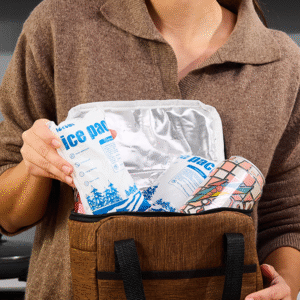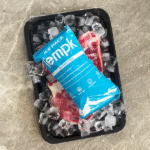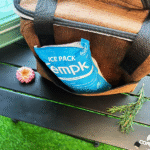When shipping frozen goods, the challenge is keeping products cold without creating leaks, condensation or safety hazards. Vacuum sealed dry ice packs combine the power of dry ice with vacuum packaging to reduce sublimation and moisture while maintaining safe temperatures. In the first 50 words, vacuum sealed dry ice pack technology is introduced as a solution to extend cold retention, limit carbon dioxide release and meet hazmat regulations. Industry guidelines emphasise venting for carbon dioxide gas and proper labeling, and the article will show how vacuum seals can help you comply.
Why vacuum sealed dry ice packs outperform traditional packaging: how removing air reduces dry ice sublimation and improves cold retention while meeting safety regulations.
How to use vacuum sealed packs safely: step by step guidance on packaging, venting and labeling, drawing from hazmat shipping rules.
Applications in pharmaceuticals, food and e commerce: realistic scenarios showing where vacuum sealed dry ice packs provide value.
Trends for 2025: technological advances like vacuum insulated panels and digital temperature monitoring, plus sustainability initiatives.
Frequently asked questions: quick answers about weight limits, disposal and differences between vacuum sealed dry ice packs and other refrigerants.
What Makes Vacuum Sealed Dry Ice Packs Different from Traditional Packaging?
Vacuum sealed dry ice packs use low pressure bags to hold dry ice, minimizing the amount of air around the carbon dioxide pellets and thereby slowing sublimation and limiting condensation. Traditional dry ice packs rely on loose pellets in insulated containers; they work but they waste space and allow moisture to form. Vacuum sealing locks the dry ice in a tailored pouch so it fits snugly against your product and reduces gas pockets. This approach makes shipments more predictable because the dry ice sublimates more slowly and the packaging stays dry. Hazmat guidelines require packaging to allow the gas to vent and to avoid airtight containers; vacuum sealed bags are designed with small vent channels or one way valves, so they remain safe while reducing oxygen intrusion.
Removing excess air reduces convective heat transfer, meaning less dry ice is needed to keep items frozen. The pouches can be custom shaped, so they fit around vaccines, biologics or frozen food and eliminate empty spaces that otherwise would need additional insulation. Guidelines for dry ice shipping emphasize filling empty space, wrapping temperature sensitive items and avoiding brittle plastics. Vacuum sealed packs satisfy these requirements by providing form fitting packaging that protects the product and slows sublimation. Each bag is made from durable plastic resistant to embrittlement, meeting recommendations to avoid plastics that become brittle at low temperatures. Because the packs are sealed, they prevent contact between dry ice and the product, reducing the risk of freezer burn, while still venting through micro channels. This dual function—slowing sublimation while venting gas—makes vacuum sealed dry ice packs stand out.
Benefits of Vacuum Insulation for Frozen Shipments
Vacuum insulation has long been used in thermoses and cryogenic dewars, and similar principles apply to vacuum sealed dry ice packs. By reducing air inside the pack, heat transfer occurs mainly through conduction through the pouch material rather than convection. The result is longer cold retention, less dry ice consumption and fewer temperature fluctuations. Laboratory guidelines recommend 5–10 pounds of dry ice per 24 hours of transit for standard shipments. In practice, vacuum sealed packs can meet the same requirements with less dry ice because less of the solid carbon dioxide sublimates. The reduced sublimation also means less carbon dioxide gas must be vented, which helps maintain safe conditions.
Below is a comparison of different refrigeration methods for shipments:
| Packaging method | Estimated cold retention (24 h) | Typical dry ice requirement | What it means for you |
| Vacuum sealed dry ice pack | 36–72 hours (with proper insulation) | 3–7 lbs per 24 h | Lower dry ice consumption; compact, form fitting packaging that reduces condensation and fits into small boxes. |
| Loose dry ice in insulated box | 24–48 hours (depending on insulation) | 5–10 lbs per 24 h | Good for simple shipments but more dry ice needed; potential for moisture and condensation as ice sublimates. |
| Gel or water based ice packs | 12–24 hours | N/A (frozen gel) | Suitable for chilled but not frozen products; cannot achieve –78.5 °C of dry ice; may leak water. |
Practical Tips and Advice
For overnight shipments: Vacuum sealed packs allow you to reduce the amount of dry ice by about 30 % compared with loose pellets. Use 3–5 pounds of dry ice for small vaccine shipments, and ensure there is a vent path; never seal the pack into an airtight cooler.
For multi day deliveries: Combine vacuum sealed dry ice packs with foam insulation or vacuum insulated panels to extend cold retention to 72 hours. Use multiple packs and distribute them evenly around the product.
For consumer deliveries: If shipping frozen food to customers, vacuum sealed packs maintain cold quality while keeping packaging tidy. Choose pouches with one way valves to prevent rupture and clearly label the outer box with “Dry Ice, UN1845” and the net weight.
Real world example: A biotech company shipping monoclonal antibodies switched from loose dry ice to vacuum sealed packs. By customizing pouch sizes and using 4 lbs of dry ice per shipment instead of 7 lbs, they extended cold retention to 60 hours and reduced condensation. The company reported fewer customer complaints about wet packaging and improved regulatory compliance.
How to Use Vacuum Sealed Dry Ice Packs Safely?
Safety begins with understanding that dry ice is a hazmat, classified as a Class 9 miscellaneous dangerous substance because it releases carbon dioxide gas that can cause explosion or suffocation. Therefore, vacuum sealed dry ice packs must be designed to vent gas while preventing moisture. The following guidelines ensure safe usage:
Choose proper packaging: Regulatory bodies require that dry ice shipments have packaging that allows gas to escape and maintains package integrity. Vacuum sealed packs meet this need by integrating vent channels or membranes; avoid fully airtight seals. The outer box should be sturdy fiberboard or polystyrene with insulation and must not be air tight.
Label the shipment: Every package containing dry ice must be marked with “Carbon Dioxide, Solid” or “Dry Ice” and the net weight. Air shipments also require a shipper’s declaration, although surface mail may not. Include the contents being cooled (e.g., vaccines) and affix a Class 9 hazard label.
Limit dry ice quantity: Many regulations restrict the quantity of dry ice. USPS domestic air shipments allow up to 5 lbs per package, while the U.S. Department of Transportation limits individual packages to 5.5 lbs in some contexts. Plan shipments accordingly, and for larger loads, break them into multiple packages.
Train staff and wear PPE: Personnel handling dry ice need IATA or DOT hazmat training. Always wear cryogenic gloves, eye protection and long sleeves to prevent frostbite. Training should be renewed at least every two years.
Vent during storage and transport: Store vacuum sealed dry ice packs in ventilated rooms or fume hoods. During transport, crack windows or use compartments with airflow to prevent carbon dioxide build up. Never seal dry ice in a closed vehicle or airtight container; a 1 lb block of dry ice releases about 250 liters of CO₂ gas as it sublimates.
Safety Best Practices and PPE
The key hazards associated with dry ice are suffocation, explosion from pressure build up and frostbite. Suffocation can occur when carbon dioxide gas displaces oxygen; concentrations above 5,000 ppm are dangerous. Vacuum sealed packs help manage gas release but do not eliminate the hazard. Always provide venting and avoid storing in confined spaces. When handling packs, use cryogenic gloves and eye protection. Do not allow the pack to contact bare skin; dry ice can cause severe frostbite within seconds. When disposing of unused dry ice, let it sublimate in a fume hood or outdoors; never pour dry ice into drains or trash. Below is a summary of hazards and protective measures:
| Hazard | Source | Protective measures | Practical significance |
| Asphyxiation | CO₂ gas displaces oxygen during sublimation | Ventilate storage/transport areas; do not transport in enclosed cars | Prevents breathing difficulties and unconsciousness. |
| Explosion | Gas trapped in airtight containers | Use containers that allow gas release and avoid fully sealed coolers | Prevents container rupture and potential injury. |
| Frostbite | Contact with dry ice at –78.5 °C | Wear insulated gloves, long sleeves and eye protection | Prevents skin damage and burns. |
Practical Advice and Scenarios
Laboratory shipments: Use vacuum sealed packs when shipping biological samples; attach temperature monitoring devices for regulatory compliance. Always list the net weight of dry ice on documentation and include an airbill statement like “Dry ice, UN1845”.
E commerce food deliveries: For home deliveries of frozen meals, instruct customers to open packages outdoors and handle vacuum sealed dry ice packs with gloves. Include a safety leaflet and choose packs with integrated vent valves.
Medical couriers: For vaccine distribution, plan around weight limits (5–5.5 lbs). Use multiple small packages rather than one large one. Provide training on proper disposal: let unused dry ice evaporate in a fume hood or outside.
Practical case: A hospital pharmacy routinely shipped clinical trial samples in vacuum sealed dry ice packs. They trained staff to wear cryogenic gloves and to record the net weight of dry ice on the label. The team stored shipments in ventilated cages and saw a reduction in accidental frostbite incidents.
What Are Common Applications for Vacuum Sealed Dry Ice Packs?
Vacuum sealed dry ice packs are ideal for applications that require frozen or ultra cold temperatures without liquid water. They are widely used in the pharmaceutical industry to transport vaccines, biologic drugs and diagnostic specimens, where strict temperature control ensures efficacy. For example, mRNA vaccines require storage below –60 °C and benefit from the extended cold retention provided by vacuum sealed packs. Food and meal kit companies use them to deliver frozen seafood, meat and gourmet desserts while preventing soggy packaging. E commerce retailers use vacuum sealed dry ice packs to ship frozen items, offering customers a clean unboxing experience.
These packs also serve researchers and laboratories shipping enzymes, cell cultures and reagents. When transporting specimens for pathology or epidemiological studies, vacuum sealed dry ice packs keep samples stable and reduce contamination risk. Outdoor enthusiasts sometimes use vacuum sealed packs for camping or hunting trips to preserve game meat; however, always follow safety guidelines to vent gas and avoid airtight coolers. In each scenario, the key advantages are consistent temperature, tidy packaging, and compliance with hazmat regulations.
How Does Vacuum Sealing Extend Dry Ice Life?
Vacuum sealing reduces dry ice sublimation by eliminating air gaps and minimizing heat transfer via convection. In a loose dry ice shipment, warm air circulates around the pellets, accelerating sublimation and causing condensation. Vacuum sealed packs remove most of this air and compress the dry ice into a solid mass. The result is slower sublimation and more uniform cooling. Because the dry ice remains in contact with the product, heat transfer occurs directly through the plastic barrier. If you combine vacuum sealed packs with foam insulation or vacuum insulated panels, the reduction in heat gain is even greater.
Regulatory guidelines provide additional context. Packages must allow carbon dioxide gas to vent. Manufacturers design vacuum sealed packs with micro vents or breathable membranes that maintain low internal pressure. Without venting, the container could explode. By controlling the number of vents, pack makers strike a balance between slowing sublimation and preventing pressure build up. This controlled environment extends dry ice life and reduces the quantity needed. A vacuum sealed pack may maintain –78.5 °C for 36–72 hours, whereas loose dry ice often lasts only 24–48 hours. The improved efficiency lowers shipping costs and carbon footprint.
Science Behind Sublimation
Dry ice sublimates directly from solid to gas. The rate depends on surface area, temperature and airflow. Vacuum sealing reduces surface area exposed to air and reduces convective heat transfer. In physics terms, convective heat transfer coefficient decreases when air is removed. The remaining heat transfer is through conduction across the pouch’s plastic film and radiation. Because conduction through thin plastic is slower, the dry ice sublimates at a controlled rate. Understanding this helps you size packages appropriately: use thicker pouches and minimize headspace to slow sublimation, but include venting to comply with regulations.
Tips for Maximizing Cold Retention
Match pack size to product volume: Oversized vacuum sealed packs have extra air and increase sublimation. Choose pack sizes that fit snugly around your product.
Use multiple smaller packs: Instead of a single large bag, use several smaller vacuum sealed packs distributed evenly. This ensures even cooling and allows easier venting.
Combine with insulation: Use polystyrene foam or vacuum insulated panels to reduce external heat gain. Keep shipments out of direct sunlight and high temperature environments.
Plan for transit time: For shipments longer than 48 hours, add extra packs or choose active refrigeration. Consult the consignee to ensure prompt receipt.
Case study: A seafood subscription service combined vacuum sealed dry ice packs with reflective insulation. They reduced ice usage by 35 %, extended delivery zones from two to three days and received positive feedback on packaging cleanliness.
2025 Latest Developments and Trends in Vacuum Sealed Dry Ice Packaging
The cold chain industry is evolving rapidly. In 2025, several trends shape the development of vacuum sealed dry ice packs and related technologies:
Technological Advances
Vacuum insulated panels (VIPs): Used in conjunction with vacuum sealed dry ice packs, VIPs provide superior insulation with thin walls, allowing smaller, lighter packages. These panels incorporate nanoporous materials that greatly reduce thermal conductivity, prolonging cold retention.
Phase change materials (PCMs): Manufacturers are integrating PCMs that freeze at –30 °C or –65 °C into vacuum sealed packs to pre condition shipments and maintain stable temperatures when dry ice is scarce or regulated. PCMs can also reduce the amount of dry ice needed.
Smart sensors and IoT: Temperature loggers and GPS trackers are being embedded into packaging. Shippers can monitor temperature and location in real time, ensuring that vacuum sealed dry ice packs maintain required conditions. Data analytics help optimize quantity and predict sublimation rates.
Sustainability and Regulation
Carbon footprint reduction: Companies aim to decrease dry ice consumption to lower CO₂ emissions and costs. Vacuum sealed packs, by reducing sublimation, contribute to this goal. Many carriers encourage using less dry ice, but within regulatory limits of 5–5.5 lbs per package.
Reusable packaging: Some suppliers now offer reusable vacuum sealed packs with durable plastic films and replaceable venting valves. After use, they can be returned, cleaned and refilled, aligning with circular economy initiatives. Guidelines caution against reusing boxes without cleaning, but reusable pouches designed for this purpose overcome that concern.
Alternative refrigerants: Research explores dry ice alternatives such as solid nitrogen or carbon dioxide snow that is produced on demand at shipping hubs. However, dry ice remains the preferred refrigerant for ultra cold shipments because it is widely available and inexpensive.
Market Insights
Consumer demand for temperature sensitive deliveries continues to grow as e commerce expands. Meal kit subscriptions, online pharmacies and direct to patient pharmaceutical services drive demand. According to industry surveys, the number of cold chain parcels shipped globally increased by more than 15 % year over year in 2024, and this growth is expected to continue into 2025. Companies adopting vacuum sealed dry ice packs report improved customer satisfaction due to cleaner packaging and fewer thawed goods. Additionally, regulatory authorities are tightening enforcement of hazmat labeling and training requirements, which makes compliance a key competitive advantage.
Frequently Asked Questions
Q1: How much dry ice should I use per vacuum sealed pack?
It depends on the product’s thermal mass and transit time. Guidelines recommend 5–10 lbs of dry ice per 24 hours for standard shipments. Vacuum sealed packs reduce sublimation, so you may need 30 % less. Always weigh the dry ice and write the net weight on the label.
Q2: Do vacuum sealed dry ice packs require venting?
Yes. All dry ice packaging must allow gas to escape to prevent pressure build up. Vacuum sealed packs incorporate micro vents or membranes. Never place a sealed vacuum pack in an airtight cooler.
Q3: Can I reuse vacuum sealed dry ice packs?
If the manufacturer designed them as reusable and they can be properly cleaned, yes. But do not reuse disposable packs or boxes without cleaning because residual contaminants could harm shipments. Always inspect vent valves and seams before reuse.
Q4: What is the maximum amount of dry ice allowed per package?
USPS domestic air shipments limit dry ice to 5 lbs, and other regulations impose a 5.5 lb cap. When sending larger quantities, divide the shipment into multiple packages and ensure each is labeled correctly.
Q5: How should I dispose of unused vacuum sealed dry ice packs?
Open the packs and let the dry ice sublimate in a well ventilated area or fume hood; do not pour it down the drain or place it in the trash. Dispose of the plastic pouch according to local recycling guidelines.
Summary and Recommendations
Vacuum sealed dry ice packs offer a more efficient and cleaner way to ship frozen goods. By removing air and tailoring the pouch to the product, these packs reduce dry ice sublimation and extend cold retention. They also help meet hazmat requirements for venting and labeling while reducing the risk of condensation and freezer burn. Key takeaways include:
Vacuum sealing minimizes convection and slows sublimation, decreasing dry ice usage by up to 30 % compared with loose pellets.
Always allow carbon dioxide gas to vent and label shipments with net weight and hazard information.
Adhere to weight limits (5–5.5 lbs per package) and wear proper PPE.
Use vacuum sealed packs in pharmaceuticals, food deliveries and laboratory shipments for cleaner, safer packaging.
Keep up with 2025 trends like VIPs, phase change materials and smart sensors to improve efficiency.
Action Plan
Assess your shipping needs: Determine transit times, temperature requirements and regulatory obligations. Consult carriers about weight limits.
Select the right vacuum sealed packs: Choose sizes that fit your products and include vent valves. Confirm whether the packs are reusable.
Implement best practices: Train staff on hazmat rules, label packages correctly, and use PPE.
Monitor and optimize: Use temperature loggers and collect feedback from customers. Adjust dry ice quantities and packaging as needed.
Engage with partners: Work with suppliers like Tempk to obtain high quality vacuum sealed dry ice packs and stay updated on innovations.
About Tempk
Tempk is a leader in cold chain packaging solutions, offering a range of dry ice products, vacuum sealed packs, insulated containers and temperature monitoring devices. Our engineers understand hazmat shipping requirements and design products that comply with international regulations while maximizing efficiency. We prioritize sustainable materials and reusability, helping our clients reduce waste and carbon footprint. With years of experience serving pharmaceutical, biotech and food industries, we have earned a reputation for reliability and innovation.
Call to action: Ready to upgrade your cold chain shipments? Contact Tempk’s experts for a consultation and discover how our vacuum sealed dry ice packs can improve your logistics. We can help you select the right packaging, implement safety practices and adopt new technologies to stay ahead in 2025.























